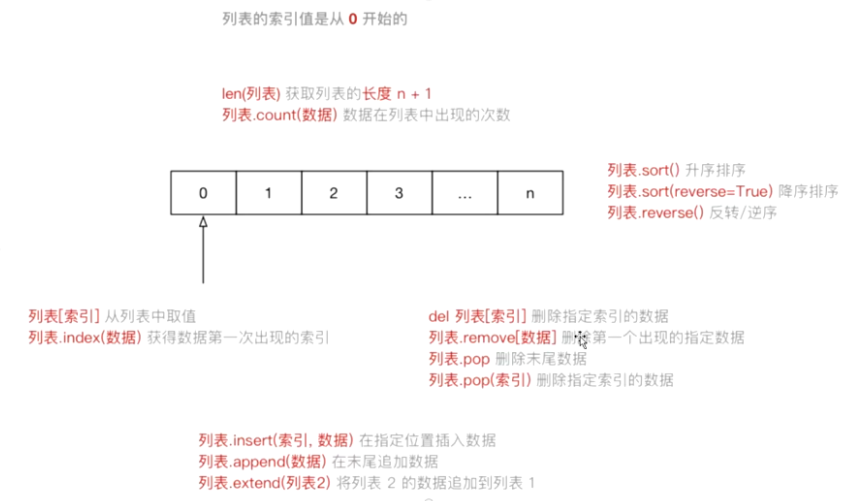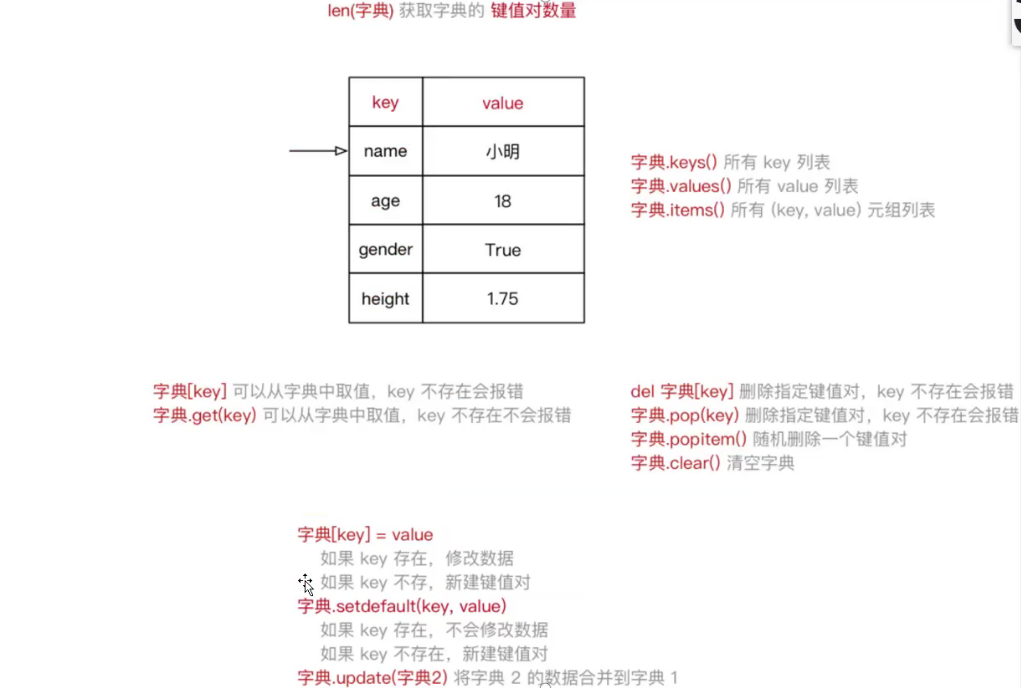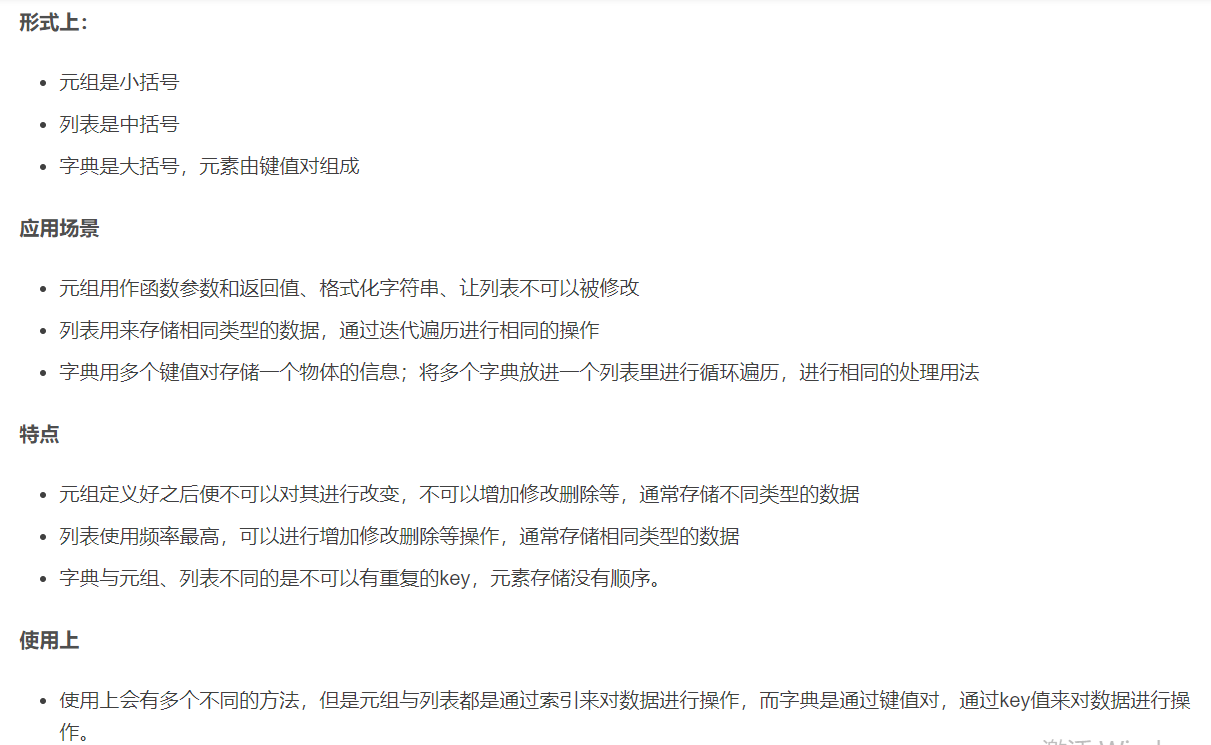1.列表
- List(列表) 是 Python 中使用最频繁的数据类型
- 列表可以完成大多数集合类的数据结构实现。它支持字符,数字,字符串甚至可以包含列表(即嵌套)
- 列表用 [ ] 标识,是 python 最通用的复合数据类型

#列表 str1 = ["chenran","帅哥","男","aihao"] str2 = ["hello","python"] str3 = [1,1,22,33,33,22,444] print(len(str1)) #打印列表的长度 print(str1.count("帅哥")) #统计列表中成员变量的数量 #运行结果为: 4 1 ####################################################### #查--取值--列表变量名[索引]开始 print(str1[1]) #取列表索引为1的值 print(str1[-1]) #取列表索引最后一个值 print(str1[::-1]) #倒序排序 print(str1.index("帅哥")) #取出str1中”帅哥“索引 #运行结果为: 帅哥 aihao ['aihao', '男', '帅哥', 'chenran'] 1 ####################################################### #对列表进行新增成员变量 str2.append("hahah") #列表末尾增加新的成员 print(str2) str2.insert(0,"美女") #在列表索引为0的位置插入成员值 print(str2) str2.extend(str3) #连接两个列表 print(str2) #运行结果为: ['hello', 'python', 'hahah'] ['美女', 'hello', 'python', 'hahah'] ['美女', 'hello', 'python', 'hahah', 1, 1, 22, 33, 33, 22, 444] ###################################################### str3.reverse() #列表反转 print(str3) str3.sort() #升序排序 print(str3) str3.sort(reverse=True) #降序排序 print(str3) #运行结果为: [444, 22, 33, 33, 22, 1, 1] [1, 1, 22, 22, 33, 33, 444] [444, 33, 33, 22, 22, 1, 1] ###################################################### del str1[1] #删除索引为1的数据 print(str1) str1.remove("男") #删除成员变量为”男“的变量 print(str1) str2.pop() #删除末尾数据 print(str2) str2.pop(2) #删除指定索引的数据 print(str2) #运行结果为: ['chenran', '男', 'aihao'] ['chenran', 'aihao'] ['美女', 'hello', 'python', 'hahah', 1, 1, 22, 33, 33, 22] ['美女', 'hello', 'hahah', 1, 1, 22, 33, 33, 22]
2.集合{}
#列表去重用集合显示 lista=[1,1,22,33,33,22,444] seta = set(lista) #列表去重 print(seta) #运行结果为:{1, 444, 22, 33}
3.字符串运算符:
print("*" * 10) #运行结果为:********** str1 = "我爱" str2 = "你" print(str1 + str2) #运行结果为:我爱你
4.字典:
- 字典(dictionary)是除列表以外python之中最灵活的内置数据结构类型。列表是有序的对象集合,字典是无序的对象集合。
- 两者之间的区别在于:字典当中的元素是通过键来存取的,而不是通过偏移存取。
- 字典用"{ }"标识。字典由索引(key)和它对应的值value组成。

#字典 a = {"name":"chenran","city":20,"爱好":"篮球"} b = {"friends":"小名","sex":"男"} b.update(a) #a字典合并到b字典中 print(b) #运行结果为:{'friends': '小名', 'sex': '男', 'name': 'chenran', 'city': 20, '爱好': '篮球'} print(len(b)) #字典键值对的数量 #运行结果为:5 print(b["friends"]) #字典key取值,key不在会报错 #运行结果为:小名 print(b.get("friendss"))#字典key取值,key不在不会报错 #运行结果为:None print(b.keys()) #字典的所有key #运行结果为:dict_keys(['friends', 'sex', 'name', 'city', '爱好']) print(b.values()) #字典的所有value #运行结果为:dict_values(['小名', '男', 'chenran', 20, '篮球']) print(b.items()) #字典的所有(key,value)元组列表 #运行结果为:dict_items([('friends', '小名'), ('sex', '男'), ('name', 'chenran'), ('city', 20), ('爱好', '篮球')]) del b["friends"] #指定key删除列表中数据,key不存在会报错 print(b) #运行结果为:{'sex': '男', 'name': 'chenran', 'city': 20, '爱好': '篮球'} b.pop("name") #指定key删除列表中数据,key不存在会报错 print(b) #运行结果为:{'sex': '男', 'city': 20, '爱好': '篮球'} b.popitem() #随机删除一个键值对 print(b) #运行结果为:{'sex': '男', 'city': 20} b.setdefault("房子","gangxu") #随机插入一个键值对 print(b) #运行结果为:{'sex': '男', 'city': 20, '房子': 'gangxu'}
5.元组
- 元组是另一个数据类型,类似于 List(列表)。
- 元组用 () 标识。内部元素用逗号隔开。但是元组不能二次赋值,相当于只读列表。
tuple = ( 'runoob', 786 , 2.23, 'john', 70.2 ) tinytuple = (123, 'john') print tuple # 输出完整元组 print tuple[0] # 输出元组的第一个元素 print tuple[1:3] # 输出第二个至第四个(不包含)的元素 print tuple[2:] # 输出从第三个开始至列表末尾的所有元素 print tinytuple * 2 # 输出元组两次 print tuple + tinytuple # 打印组合的元组 #运行结果为: ('runoob', 786, 2.23, 'john', 70.2) runoob (786, 2.23) (2.23, 'john', 70.2) (123, 'john', 123, 'john') ('runoob', 786, 2.23, 'john', 70.2, 123, 'john')

